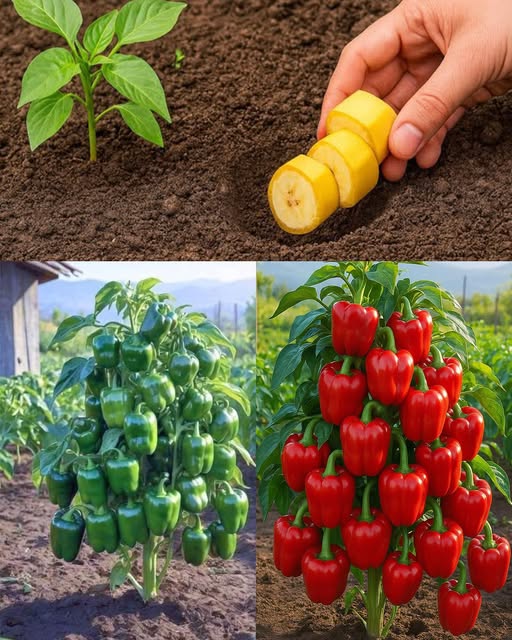Gardening is full of clever, time-tested secrets—and here’s one you probably haven’t tried yet: planting a chopped banana beneath your pepper plants. It might sound strange, but this simple trick can lead to healthier plants, bigger yields, and zero chemical fertilizers.
Let’s break down how this works, why it’s so effective, and how to do it right at home.

🧪 Why Peppers Need a Nutrient Boost
Peppers are what gardeners call “heavy feeders.” That means they need rich, nutrient-dense soil to grow strong stems, lush leaves, and vibrant fruit. They especially thrive on:
- Potassium – crucial for flower and fruit production
- Phosphorus – supports healthy root growth
- Calcium – strengthens plant cell walls, helps prevent blossom-end rot
- Magnesium – vital for photosynthesis and lush green leaves
- Trace minerals – like manganese and copper for disease resistance
And guess what contains all of these? That’s right: a banana.
🍌 What’s in a Banana That Helps Pepper Plants?
A ripe banana is nature’s slow-release fertilizer. As it breaks down in the soil, it feeds your plant exactly the nutrients it craves—without any store-bought chemicals. The combination of essential minerals helps pepper plants:
- Produce more flowers and fruit
- Grow stronger, thicker stems
- Resist disease and stress
- Absorb nutrients more efficiently
🌱 How to Use a Banana When Planting Peppers
This method is easy, cheap, and highly effective. Here’s a step-by-step guide:
✅ Step 1: Chop the Banana
Take a ripe or overripe banana (peel and all) and cut it into small chunks. The smaller the pieces, the faster they’ll decompose and release nutrients.
✅ Step 2: Dig the Hole
Make a planting hole in your garden bed or container. It should be deep enough for both the banana pieces and your pepper seedling’s root ball.
✅ Step 3: Add the Banana
Drop the chopped banana into the bottom of the hole and spread it out evenly.
✅ Step 4: Cover with Soil
Before planting, add about 2 inches of soil over the banana. This protects the roots from direct contact and helps prevent root burn.
✅ Step 5: Plant Your Pepper
Set the seedling on top of the soil layer and plant it as usual. Water well after planting.
🌿 What to Expect After Using This Trick
Gardeners who’ve tried this method often notice:
- Faster growth and stronger stems
- Deeper green leaves
- More flowers = more peppers
- Larger, better-tasting fruit
- Fewer issues with pests or disease
And the best part? You’re recycling food waste while skipping synthetic fertilizers.
💡 Bonus Tips for Even Better Results
- Freeze your bananas if you’re not planting right away—just thaw before use.
- Add crushed eggshells for extra calcium or coffee grounds for a nitrogen boost.
- Works great in containers, raised beds, or traditional garden plots.
🔍 Why This Method Works So Well
Unlike traditional fertilizers, the banana is buried right under the root zone, where the plant can draw nutrients as it grows. This keeps nutrients from washing away in rain or watering—and delivers consistent feeding during the long pepper season.
It’s especially helpful for peppers, which hate nutrient fluctuations and thrive on steady support.
🌎 Eco-Friendly, Budget-Friendly Gardening
Using bananas under your pepper plants is one of those simple gardening hacks that just works. It’s:
- Chemical-free
- Waste-reducing
- Budget-friendly
- Beginner-approved
Whether you’re a seasoned gardener or just starting out, this trick is worth trying. Your pepper plants will reward you with bigger, healthier, tastier harvests—naturally.
⚠️ Disclaimer: Every garden is different. Always monitor your soil and plant health. While this method is generally safe and effective, some adjustment may be needed depending on your growing conditions.
Inspired by this tip? Share it with a fellow gardener and spread the knowledge! 🌱





